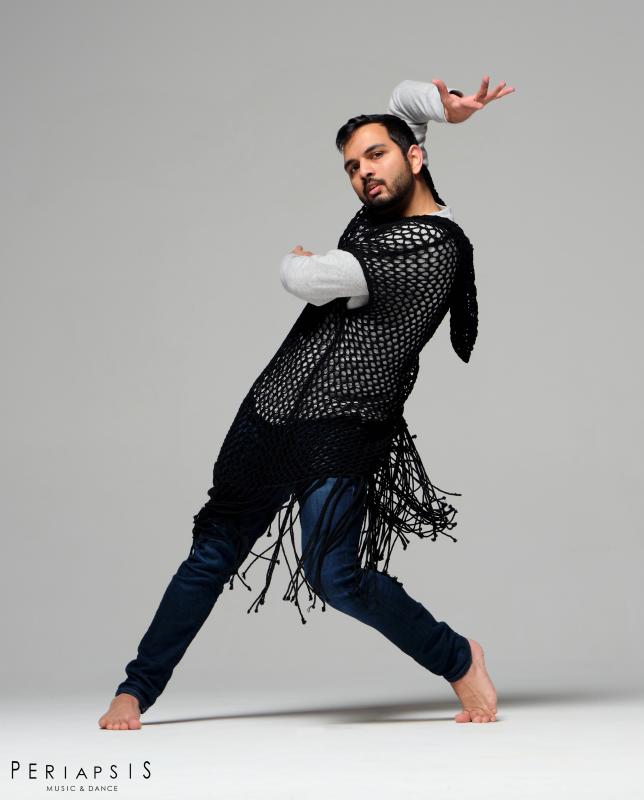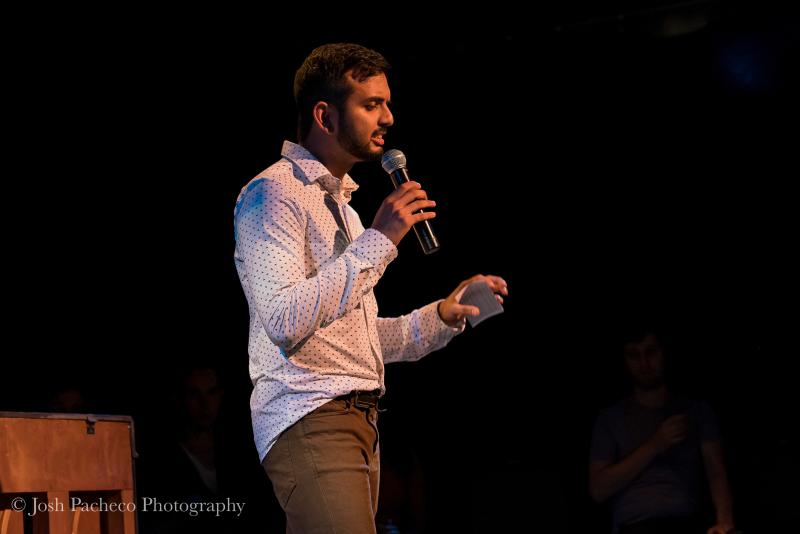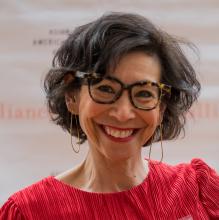Art Talk with Dancer and Choreographer Rohan Bhargava

Photo by Andrew Fassbender for Rachel Neville Photography, courtesy of Periapsis Music and Dance
When Rohan Bhargava was growing up in New Delhi, India, dance was a consistent presence in his life.
“There are videos of me since I was like three years old just improvising and expressing myself through movement,” he told the National Endowment for the Arts. “I think it came a lot from watching movies and TV shows and in India, there’s a huge culture of music and dance in the film and TV industry.”
As a child, Bhargava remembers gathering his parents’ houseguests and asking them for a small fee to watch him perform. Seeing his passion for dance, his parents enrolled seven-year-old Bhargava in a local dance academy that focused on jazz. That was the beginning of his dance training, which would eventually lead him to New York University’s Tisch School of the Arts.
Now based in New York City, Bhargava is trained in jazz, ballet, contemporary, modern, and hip hop. He founded his own dance company, Rovaco, in 2015 and serves as its artistic director. He has received a number of prestigious commissions, residencies, and fellowships, including the 2020 Jadin Wong Fellowship from the Asian American Arts Alliance.
Bhargava sat down with the Arts Endowment via videochat to talk about his work as a dancer and choreographer, creating space for other performers to share their unique stories, and creating a multi-sensory experience for audiences.
NEA: Narrative is a strong through line in your work. How would you describe your creative process in creating narrative performances?
Rohan Bhargava: I like to start with an initial concept or image or a real-life experience and try to convert that idea into movement through task-based exploration in collaboration with my dancers, and, because it is based off an idea, [the work] ends up being narrative. I’m also really interested in quotidian gestures and the human things that we do. When you take those things and start converting them into movement, even as it gets abstract, it still has that intention of where it came from, which was this human thing.
In my current piece that I’m choreographing for Periapsis Music and Dance, I wanted to touch on this idea of how we modify or conceal our identity in order to assimilate. For me, it's coming from a queer and South Asian perspective of wanting to assimilate or not wanting to show my queerness growing up. [One way] we played with this idea was we hid one body behind three other bodies and then had their hands come out of the negative spaces only to be kind of retracted back.
I think collaboration plays a really key role here. I like to tell my dancers what the piece is going to be about what I’m curious about or what I’m researching. I bring that into the rehearsal. If there are some images, videos, I share that with them. I think their perspective and their voices need to also have ownership in the material because otherwise, it feels alien. If I want to tell a story and I want it to feel human, then the people who are telling that story need to actually relate to it on a deep level.
NEA: What inspired you to start your own dance company?
Bhargava: I actually didn’t think that I was going to start a dance company. It was just how all the planets aligned. I graduated and I still didn’t feel confident in my dancing, like auditioning skills, and so there was this void. I was, of course, really interested in choreographing, so I just asked a bunch of people who I was already working with like “Hey, we still have access to the studio space. You want to just come in and play with some ideas?”
I realized that when I started creating work outside of college that I really found a voice that was more free to dive into ideas that I hadn’t really thought about during college. I also understood that because I now had this freedom from academic ideals, I was also able to communicate better to audiences. Seeing how all those things started aligning made me realize, "You know, actually, I want to continue creating this opportunity for my fellow artists."
The reality of it is also that I’m an immigrant. I was also worried about getting an artist visa and once you graduate, you have [a limited time] to get an artist visa. This artist visa has these really specific and very hard qualifications that you need to prove you’re an artist who’s leading in the dance field, who’s wanted by different companies, or who’s the lead person in different projects and so, starting the company also meant for me, since I don’t have a lot of work as a dancer and my work as a choreographer seems to be really connecting with me and as well as other people, maybe this is the way that I can actually apply for this artist visa. If I had my own company, then I would have programs and press materials and stuff that I can show to the immigration authority saying that “Actually, I am doing work that deserves to be presented and that’s why I deserve to stay in the United States.” So, all of that coming together made me want to start my company.
NEA: Part of Rovaco’s mission statement is to start conversations, whether about politics, social dynamics, or culture. How do you do that in your performances, especially for people who are maybe less familiar with dance?
Bhargava: I think our bodies and our stories are inherently social, cultural, and political. I don’t like to necessarily make a statement about a social aspect or a political or cultural aspect. I like to go from this idea of what is my personal story, what is something that I feel I have ownership about that I can authentically say something about. I can say I had this experience and I can convert that into movement because I’ve had that physical experience. Because my experiences are social, cultural, and political, those ideas just end up coming into the work.
I think more importantly, I’m really interested in creating dance as an intimate five-sensory experience for audience members. At least in my own personal productions, I have leaned toward setting up the audience [so they’re seated] in the round. I don’t want them to view dance as a spectacle. I want them to view dance as a very intimate world that we’re inviting them into.
I annually curate this event called Rovaco Dance Party, which is specifically focused on bridging that gap between the audience and the performer. This is a dance and live music event where I emcee the whole night. So, it’s informal. The audience sits in the round and I’m giving information about the pieces, who the artists are, what the work is about, and why it’s important to us because I think oftentimes, dance might not be enough. People are different kinds of learners. Some people are visual learners. Some people are oral learners. Some people need to have an experience to actually be able to talk about and some people need words. I make a point to give audiences many different points of entry into the work. I feel that authenticity of sharing what’s true to you allows other people to absorb it and at the same time, reflect how it might relate to their own experiences. I’m not preaching or making a statement; I’m just sharing.

NEA: I want to go to one of those shows because I’ve never been at a show that does that with the audience before. That would be amazing.
Bhargava: We also actually provide a cultural experience to the audience before the show. We have Indian snacks, which gives a taste experience. We do this little ceremony where we tie a red thread around their wrist, which comes from Hindu culture, and is a welcoming thing. We have incense sticks in the air, and it’s really about this idea that culture is something that is understood when you experience it. You can see culture, but then sometimes you make assumptions about what it is and what it might be about. But if someone tells you this is what it is and this is what it feels like, then you feel more related to that idea and you know why it’s important to that culture and where it comes from.
NEA: For your work, having an audience there and having that participation is so important. How did the pandemic affect that over the past couple of years?
Bhargava: We’re almost back to normal, whatever that is. I was kind of lucky during the pandemic because at the time I had this fellowship from the Jamaica Center for Arts and Learning. They honored it and they allowed [the company] to come into their theater since it was just three of us. The problem was, of course, that we had to then record and create the experiences for the audiences virtually.
The way we filmed the dance, the final product, it was very intimate – the camera would come really close and it would almost be like there were certain moments I would actually speak to the camera. So, if you were watching it at home whenever it premiered, it actually felt like I was just talking to you.
For the Jadin Wong Fellowship, we wanted to create an experience for the audience that was hands-on. Before the virtual event, we sent everyone chai-making kits. We sent them all the spices and the tea that they would need and any utensils that they might need. Then we met up on Zoom and for the first 30 minutes, we all made chai in real time. Chai is a very important beverage in India because it’s served in almost every household as a welcome beverage to guests and so, that was an introduction into my culture.
Of course, it was a shift because we couldn’t meet [the audience] in person, but I was very adamant to find ways to still make it intimate and a visceral experience as opposed to just the normal Zoom thing, where you watch something and then you’re done.
NEA: As terrible as the past few years have been, it has been interesting to see the creativity that people have brought out from having to deal with the constraints of the pandemic.
Bhargava: Exactly. I never thought that I would be sending chai-making kits and making chai on Zoom with 30 other people, but then that happened and that was actually super fun.
NEA: Your pieces deal with relationships, sex, addiction, queer life, and now, you’ve said you’re starting to delve more into Indian culture and identity. What sparked that interest for you and made you want to explore that more in the company?
Bhargava: I think I’m interested in sex, addiction, queer life, and now, Indian culture and identity, because all these things are aspects of my identity and my life that I felt at some point, or even now, I continue to struggle with or have some sort of conflict with…I didn’t have these role models and these conversations weren’t happing. I think because there was a lack of that growing up, I now feel that I have to fill in that gap and give that to the world.
I also want to create a space for other artists who are queer, other artists who are Indian to be able to embody and express their identity in positive ways and have these hard conversations that we put a taboo on. Creative-wise, I feel the most authentic expression of my movement is when I am pulling from experiences that I’ve physically had.
I had this interesting thing growing up because India was colonized by the British until 1947 and we still see a huge effect of that, like this idea that the Western culture is superior to the Eastern culture or the Indian culture. That is something that the British left in the minds of people, and that was passed down to me. When I came [to the United States], I started noticing how it was in my brain and how I tried to assimilate. That’s when I realized these subconscious feelings that we have, that kind of push our culture down in the name of assimilation or in the name of fitting into the Western culture, it made me undervalue myself. This undervaluation of Indian aesthetics is what has made me want to dive into my identity and present culture in a more positive and beautiful light.
I also felt that in the contemporary dance scene, there was no one – at least in my New York community – who was able to accurately represent queer South Asian experiences while focusing on concert dance aesthetics. I felt that there was a void, and I was curious as to how I could give a cultural experience to audiences through the tools that I learned in college, through the tools that I learned choreographing after college, and at the same time, create space for other Indian artists to appreciate their culture because that’s something that I think we all need to do more.
NEA: What advice would you have for aspiring dancers, aspiring choreographers?
Bhargava: I think especially young choreographers, we feel the need to want to speak to as many people as possible, to be as universal or create work that relates to a lot of people. I think what ends up happening because of that idea, we end up zooming out, thinking the more generic we get, the easier it will be for people to relate. I’ve realized over time that there more specific I get, the easier it is for people to relate. If I can tell someone’s story and tell people why this person is feeling the way they’re feeling in that moment, that creates empathy. The more clearly specific you can get and more clearly you can show someone’s intentions and emotions and narrative, the more universally empathetic response you’ll get from an audience.





